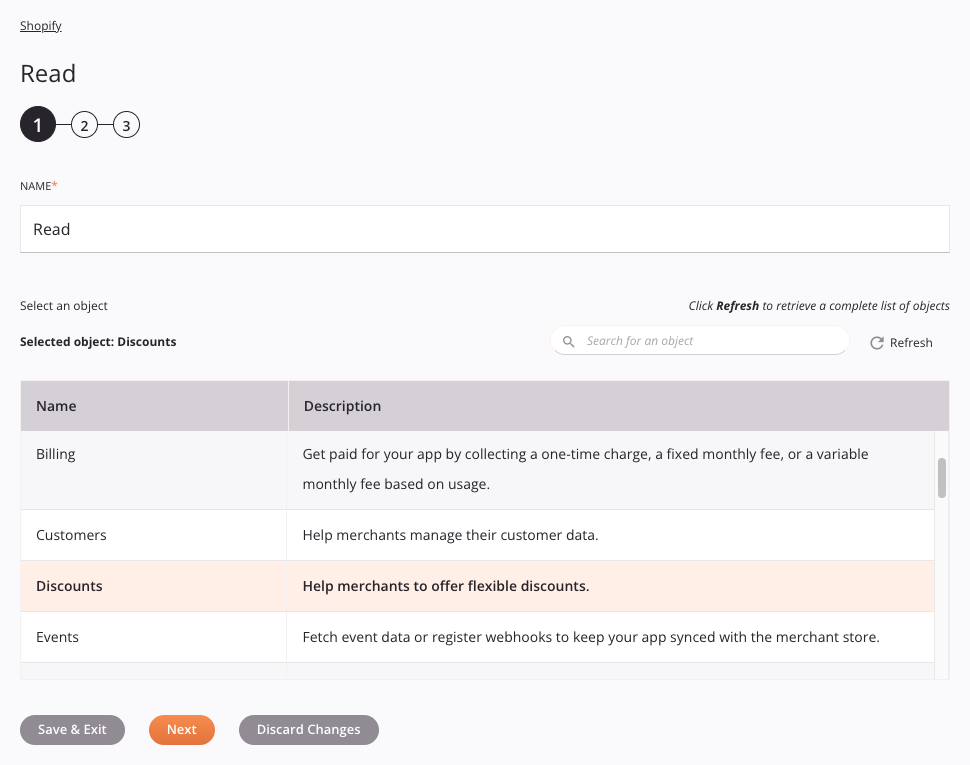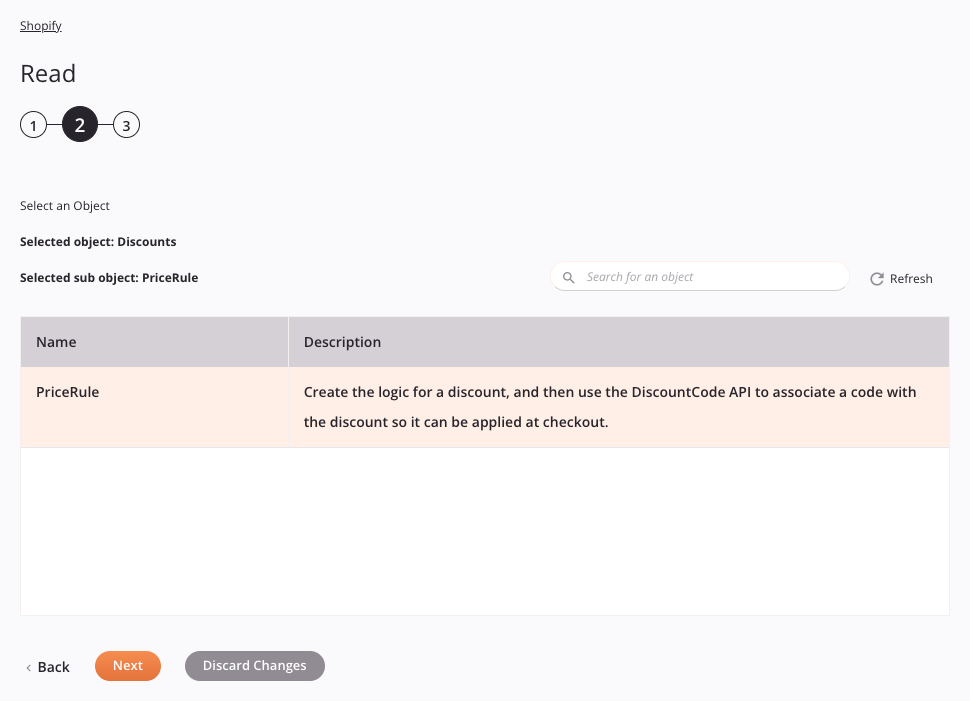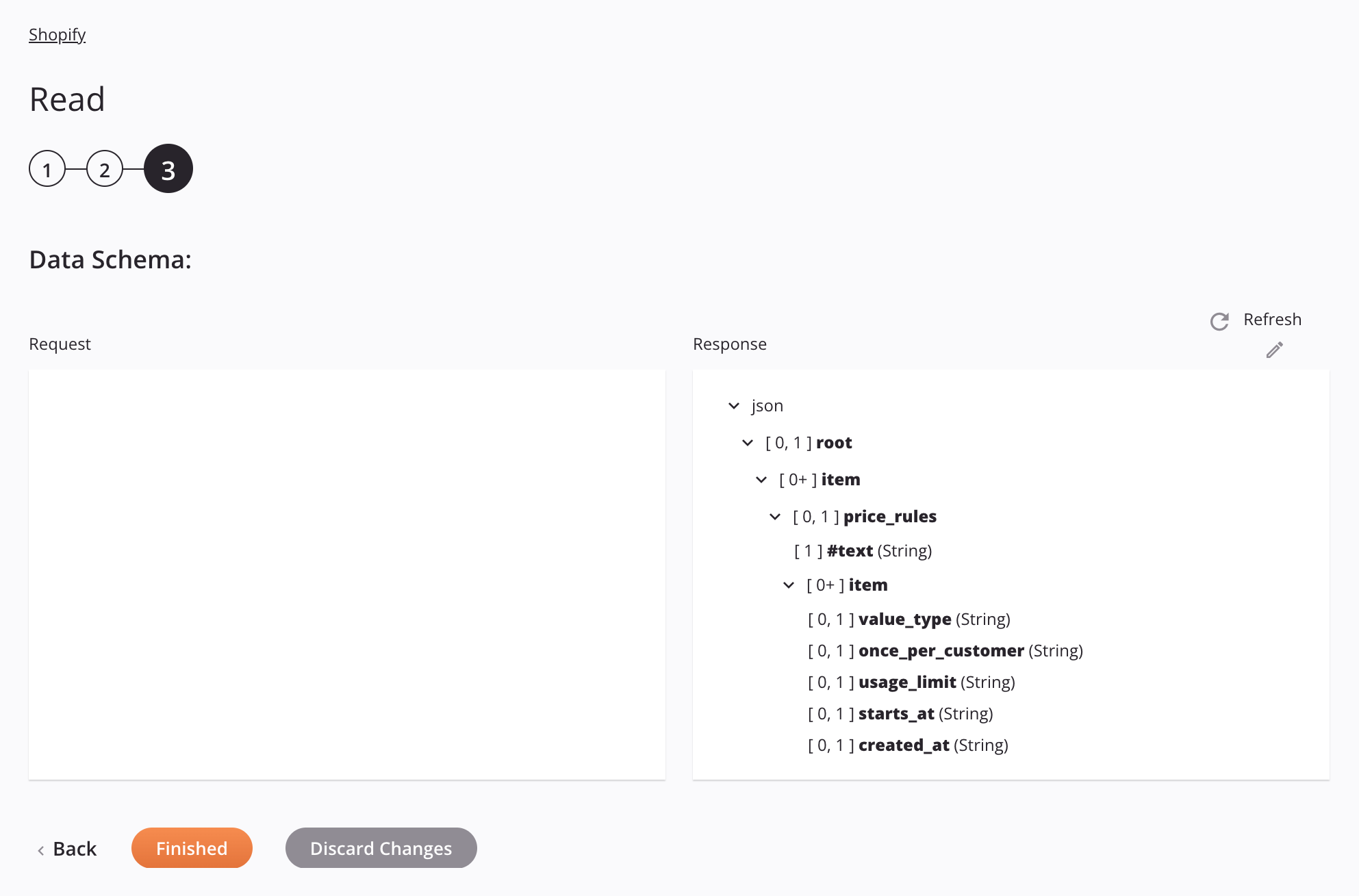Shopify Read activity¶
Introduction¶
A Shopify Read activity, using its Shopify connection, retrieves all object data from Shopify and is intended to be used as a source to provide data in an operation.
Note
The Read activity does not have a request schema and will return all data within the selected object. To retrieve a specified set of data from the selected object, use the Query activity.
Rate limits¶
The Shopify REST Admin API enforces a rate limit of 40 requests per app per store per minute. This allotment replenishes at a rate of 2 requests per second. The rate limit is increased for Shopify Plus stores. For more information on the rate limit, see Shopify REST Admin API rate limits.
Create a Shopify Read activity¶
An instance of a Shopify Read activity is created from a Shopify connection using its Read activity type.
To create an instance of an activity, drag the activity type to the design canvas or copy the activity type and paste it on the design canvas. For details, see Create an activity instance in Component reuse.
An existing Shopify Read activity can be edited from these locations:
- The design canvas (see Component actions menu in Design canvas).
- The project pane's Components tab (see Component actions menu in Project pane Components tab).
Configure a Shopify Read activity¶
Follow these steps to configure a Shopify Read activity:
-
Step 1: Enter a name and select an object
Provide a name for the activity and select the object containing the data to be retrieved. -
Step 2: Select a sub-object
Select a sub-object. -
Step 3: Review the data schemas
Any request or response schemas generated from the endpoint are displayed.
Step 1: Enter a name and select an object¶
In this step, provide a name for the activity and select the object containing the data to be retrieved. Each user interface element of this step is described below.

-
Name: Enter a name to identify the activity. The name must be unique for each Shopify Read activity and must not contain forward slashes
/or colons:. -
Select an Object: This section displays objects available in the Shopify endpoint.
-
Selected Object: After an object is selected, it is listed here.
-
Search: Enter any column's value into the search box to filter the list of objects. The search is not case-sensitive. If objects are already displayed within the table, the table results are filtered in real time with each keystroke. To reload objects from the endpoint when searching, enter search criteria and then refresh, as described below.
-
Refresh: Click the refresh icon
 or the word Refresh to reload objects from the Shopify endpoint. This may be useful if objects have been added to Shopify. This action refreshes all metadata used to build the table of objects displayed in the configuration.
or the word Refresh to reload objects from the Shopify endpoint. This may be useful if objects have been added to Shopify. This action refreshes all metadata used to build the table of objects displayed in the configuration. -
Selecting an Object: Within the table, click anywhere on a row to select an object. Only one object can be selected. The information available for each object is fetched from the Shopify endpoint:
-
Name: The name of the Shopify object.
-
Description: The description of the Shopify object.
-
Tip
If the table does not populate with available objects, the Shopify connection may not be successful. Ensure you are connected by reopening the connection and retesting the credentials.
-
-
Save & Exit: If enabled, click to save the configuration for this step and close the activity configuration.
-
Next: Click to temporarily store the configuration for this step and continue to the next step. The configuration will not be saved until you click the Finished button on the last step.
-
Discard Changes: After making changes, click to close the configuration without saving changes made to any step. A message asks you to confirm that you want to discard changes.
Step 2: Select a sub-object¶
In this step, select a sub-object. Each user interface element of this step is described below.

-
Select an Object: This section displays sub-objects available in the Shopify endpoint.
-
Selected Object: The object selected in the previous step is listed here.
-
Selected Sub-object: After a sub-object is selected, it is listed here.
-
Search: Enter any column's value into the search box to filter the list of sub-objects. The search is not case-sensitive. If sub-objects are already displayed within the table, the table results are filtered in real time with each keystroke. To reload sub-objects from the endpoint when searching, enter search criteria and then refresh, as described below.
-
Refresh: Click the refresh icon
 or the word Refresh to reload sub-objects from the Shopify endpoint. This may be useful if sub-objects have been added to Shopify. This action refreshes all metadata used to build the table of sub-objects displayed in the configuration.
or the word Refresh to reload sub-objects from the Shopify endpoint. This may be useful if sub-objects have been added to Shopify. This action refreshes all metadata used to build the table of sub-objects displayed in the configuration. -
Selecting a Sub-object: Within the table, click anywhere on a row to select a sub-object. Only one sub-object can be selected. The information available for each sub-object is fetched from the Shopify endpoint:
-
Name: The name of the Shopify sub-object.
-
Description: The description of the Shopify sub-object.
-
Tip
If the table does not populate with available sub-objects, the Shopify connection may not be successful. Ensure you are connected by reopening the connection and retesting the credentials.
-
-
Back: Click to temporarily store the configuration for this step and return to the previous step.
-
Next: Click to temporarily store the configuration for this step and continue to the next step. The configuration will not be saved until you click the Finished button on the last step.
-
Discard Changes: After making changes, click to close the configuration without saving changes made to any step. A message asks you to confirm that you want to discard changes.
Step 3: Review the data schemas¶
Any request or response schemas generated from the endpoint are displayed. Each user interface element of this step is described below.

-
Data Schemas: These data schemas are inherited by adjacent transformations and are displayed again during transformation mapping.
Note
Data supplied in a transformation takes precedence over the activity configuration.
The Shopify connector uses the Shopify REST Admin API version 2022-04, 2023-01, 2023-04, 2023-07, 2023-10, 2024-01, or 2024-04 depending on the selection in a Shopify connection. Depending on the API endpoints supported by Shopify in the API version being used, the objects and sub-objects that are available for selection may vary. Refer to the API documentation for information on the schema nodes and fields.
Important
Shopify automatically redirects calls of unsupported API versions to the next oldest supported version. Note that Shopify has deprecated certain Fulfillment API endpoints with version 2022-07, as described in Shopify fulfillment API deprecation.
-
Refresh: Click the refresh icon
 or the word Refresh to regenerate schemas from the Shopify endpoint. This action also regenerates a schema in other locations throughout the project where the same schema is referenced, such as in an adjacent transformation.
or the word Refresh to regenerate schemas from the Shopify endpoint. This action also regenerates a schema in other locations throughout the project where the same schema is referenced, such as in an adjacent transformation. -
Edit: Click the edit icon
 above the response data schema to enter the editor. The editor allows you to add, delete, and reorganize nodes and fields and change their data types. All newly added nodes and fields are set to
above the response data schema to enter the editor. The editor allows you to add, delete, and reorganize nodes and fields and change their data types. All newly added nodes and fields are set to [0, 1]cardinality. Changes made to the response data schema must be acceptable to the endpoint and should be made only after consulting any available documentation for the endpoint. -
Back: Click to temporarily store the configuration for this step and return to the previous step.
-
Finished: Click to save the configuration for all steps and close the activity configuration.
-
Discard Changes: After making changes, click to close the configuration without saving changes made to any step. A message asks you to confirm that you want to discard changes.
Next steps¶
After configuring a Shopify Read activity, complete the configuration of the operation by adding and configuring other activities, transformations, or scripts as operation steps. You can also configure the operation settings, which include the ability to chain operations together that are in the same or different workflows.
Menu actions for an activity are accessible from the project pane and the design canvas. For details, see Activity actions menu in Connector basics.
Shopify Read activities can be used as a source with these operation patterns:
- Transformation pattern
- Two-target archive pattern (as the first source only)
- Two-target HTTP archive pattern (as the first source only)
- Two-transformation pattern (as the first or second source)
To use the activity with scripting functions, write the data to a temporary location and then use that temporary location in the scripting function.
When ready, deploy and run the operation and validate behavior by checking the operation logs.